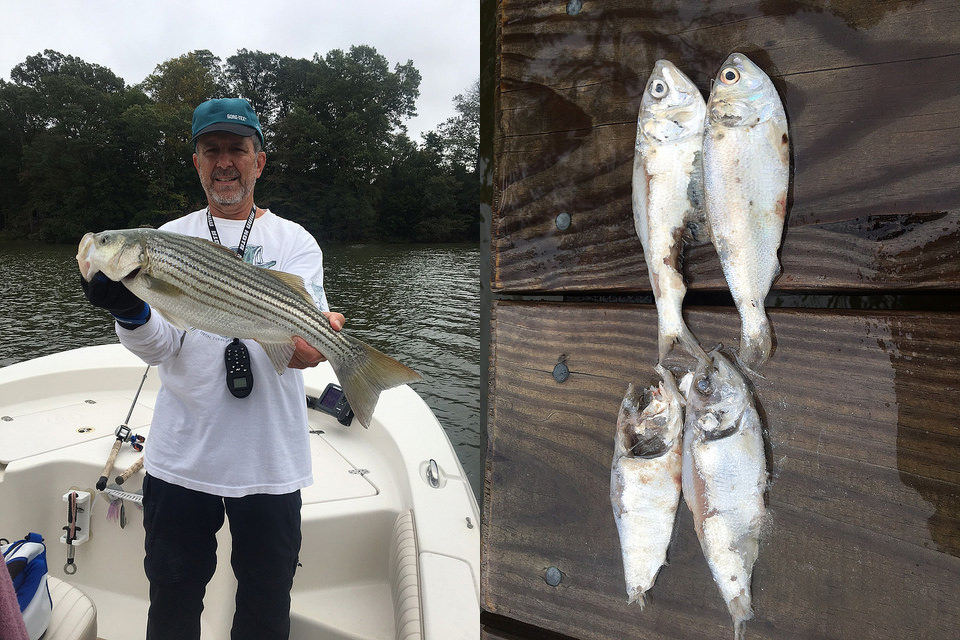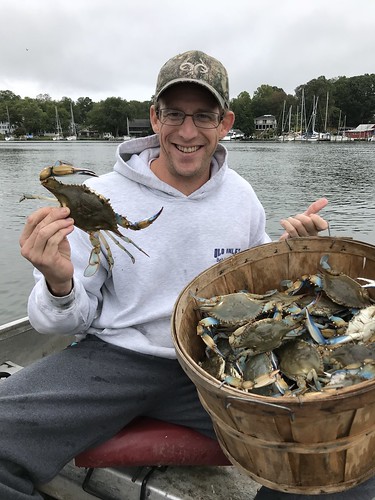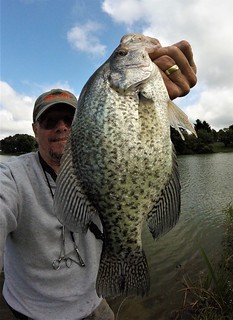Weekly Fishing Report: October 18

Herb Floyd caught this nice striped bass in the lower Choptank recently and also sent in an accompanying picture of what the striped bass have been eating. Photos courtesy of Herb Floyd
The much anticipated annual striped bass young of the year survey results have been released and they are positive.
The number of two-year-old striped bass that are being encountered in all three regions of the bay also bode well for the future of striped bass fishing in the Chesapeake Bay.
At present the two- and three-year old rockfish are feeding heavily on bay anchovies and gaining in size. As most anglers know, bay water temperatures have been a bit warmer than normal for this time of the year, and because of that the anticipated fall run of baitfish leaving the tidal rivers is behind schedule. Recently we have begun to experience some chilly nights so perhaps this will begin to drive water temperatures in the tidal rivers down into the low 60s and kick the annual fall event into gear so we can enjoy some fun jigging action.
In the upper bay region, fishing for striped bass is slowly transitioning to trolling and jigging as live spot become more difficult to find. There are still some fish being found on hard bottom off of Sandy Point, but as water temperatures cool they will be even harder to find. If you can gather up some live spot they are usually a sure ticket to catching some nice striped bass. The steep channel edges at Podickory, Love and Swan points have been good places to find suspended fish at times. Some of the shoal and knoll areas in the upper bay and the Chesapeake Bay Bridge piers have also been holding striped bass at times. Trolling a mix of small spoons, swim shad type lures bucktails and surge tubes behind inline weights or planers has been popular. Jigging over suspended fish with soft plastic jigs has also been a good option.
Good white perch fishing can be found in the tidal rivers in waters around 15 feet in depth. Jigging with dropper flies or using bottom rigs baited with bloodworms are the best way to catch them. There are also a lot channel catfish in the upper bay tidal rivers as well as flathead catfish near the Conowingo Dam. The dam has begun to release water once again on an afternoon schedule which should liven up the fishing in the lower Susquehanna River and flats this week.
Surface water temperatures in the middle bay region are holding at about 70 degrees this week so not much has changed in regard of the progression of the striped bass fishery into a typical fall mode. Live spot are still available in many of the hard bottom areas, so live lining spot along channel edges continues to be one of the better ways to try and catch a nice grade of striped bass. The channel edges at Thomas Point, Tolleys, Eastern Bay, Buoy 83, the False Channel and the Diamonds have been a few of the classic locations to look for some striped bass action.
More than a few reports are circulating of some nice striped bass being caught in shallower areas in waters 8 feet to 15 feet deep. This presents an opportunity for slow trolling with diving crankbaits or bucktails, or bottom bouncing a bucktail. This latter method consists of a fairly large sinker usually around 8 ounces or more rigged on a dropper about a foot below a three-way swivel. A leader of 6 feet to 8 feet comes off the three-way with a half-ounce to one-ounce bucktail dressed with a twister tail. The rod is held with tip on a downward angle and enough line is let out so that the sinker just hits bottom now and then and kept walking along the bottom as the bucktail is given a slight jig. This method is very effective around shallow structure such as oyster bars and ballast stone piles. You don’t see a lot of anglers fishing this way these days but it can be effective at times like this.
Before we get into this week’s fishing report, I wanted to remind everyone that they can submit their own fishing reports and photos to the Maryland Angler’s Log. To post a report, please email your name, hometown, photos, location information and additional content for your report. All information is optional, but encouraged. New reports are posted daily during the busy fishing seasons.
Jigging has been effective at times when a nice grade of fish can be found suspended over structure but the hot action we all relate to with diving gulls and hot-and-fast action has yet to really kick into high gear. There are a lot of two- and three-year-old striped bass mixed in with small bluefish chasing bay anchovies out in the channel areas of the bay, near the anchored ships and the mouths of the major tidal rivers.
Fishing for white perch continues to be good this week in some of the 15-foot or deeper areas in the tidal rivers. Jigging with dropper flies or fishing with bloodworms on a bottom rig have been a good way to fish for them. They are schooling up, presenting a great opportunity to catch a mess of nice perch.
The lower bay region is beginning to show some seasonal changes as cobia, large red drum and Spanish mackerel move south into Virginia waters. The spot are still here and large ones are still being caught around Point Lookout at Cornfield Harbor in about 12 feet to 20 feet of water. Large spot are also being caught in the lower Patuxent River and the Tangier Sound area. Some kingfish are still being caught but it would seem that they are headed south also. A mix of speckled trout, sea trout, and white perch round out the bottom fishing mix.
Due to the fact that spot are still available, live lining spot for striped bass is still one of the best ways to catch a nice grade of striped bass. The channel edges in the lower Potomac River and the Cove Point area have been popular places to give it a try.
The shallow water fishery for a mix of striped bass and speckled trout has been good in the early morning hours and late evenings. Topwater lures tend to be the best way to fish near shallow structure. On the eastern side of the bay drifting soft crab baits is still popular for speckled trout. A fair portion of the striped bass being caught fail to make the 20-inch mark but always offer plenty of fun on topwater lures.
Before we get into the crabbing, freshwater and ocean section of the report, here is the bay conditions update and fishing forecast from the team at Click Before You Cast.
Weekly Fishing Conditions Forecast Summary — Oct. 18-25
It is finally starting to feel like fall has arrived. Main bay temperatures have cooled about 6 degrees since last week and are now down to about 70 degrees. Expect stable conditions until early next week with cool, sunny days and 5-10 knot winds with possible rain early next week. These cool conditions will continue to move water temperatures and oxygen conditions towards the liking of hungry rockfish. While most Maryland waters have adequate oxygen from surface to bottom, start your search just above the “Do not fish below this depth.” In the upper bay near Swan Point (along Tolchester channel) and Baltimore Harbor avoid fishing depths below 13 feet. At the Bay Bridge on the west side, fish above 20 feet. On the east side of the bridge, don’t fish below 15 feet. From Bloody Point and into Eastern Bay, suitable oxygen can be found above 23 feet. From the Choptank River south, there is plenty of oxygenated water well below 30 feet and in many places, throughout the entire water column.
We’re introducing a new feature, Water Temperature by Depth. This helps you identify are water temperature differences from the surface down to the “Do Not Fish Below This Depth” layer. You can quickly determine whether the water column has a uniform temperature or if deeper waters are warmer or cooler than surface waters. For this week, most waters are well mixed and have uniform water temperature from surface down to the maximum fishing depth. However, in the mainstem of the bay from the Little Choptank south to the mouth of the Potomac River, maximum fishing depths are running about 2 degrees cooler than surface waters. Expect some reduced water clarity from algal blooms/mats in the Gunpowder and Back rivers and the Susquehanna Flats. However, normal flows for streams and rivers entering Maryland’s portion of the bay should not impact water clarity. In addition, there will be excellent tidal currents from Wednesday through next Tuesday as a result of the upcoming new moon on October 19-20.
For the full weekly fishing conditions summary and more detailed and up-to-date fishing conditions in your area of the bay, be sure to check out Eyes on the Bay’s Click Before You Cast. Since this is a new feature for Chesapeake Bay anglers, drop us a line with comments or suggestions.
Warm water temperatures have tended to stretch out the recreational crabbing season and those that give it try in the middle and lower bay regions have been coming home with some nice large heavy crabs. The best catches tend to be coming from waters of 15 feet or deeper. Razor clams are still the most attractive bait to the crabs as well as spot, sooks and terrapins.
The fall trout stocking program is well underway for put and take trout fishermen and there are plenty of opportunities to get out with family and friends, especially your young anglers when they get out of school at the end of the day. This is classic hatchery trout fishing, so scent- and color-enhanced dough baits and good old garden worms tend to be two of the favorite baits. Small spinners can be a great choice for the ultra-light spinning crowd and Wooley Bugger type flies for those who enjoy fly fishing. The stockings will be posted as they are completed on the trout stocking website and by the email subscription list.
River and stream flows continue to be low in many regions of the state this week. Some of the western region creeks, streams and rivers are low and clear making for some difficult fishing. Falling leaves will soon add to the headache. The upper Potomac is still running low and clear with loose grass floating. Long casts with tubes or topwater lures are in order to current breaks, submerged ledges and shaded areas of large in current boulders to find lurking smallmouth bass.
Walleye, large yellow perch and smallmouth bass fishing at Deep Creek Lake has improved due to cooler water temperatures.
Steep rocky edges are good places to fish for walleyes in the evenings with jerkbaits; crankbaits, tubes and jigs are good choices for smallmouth bass. Drifting live minnows under a slip bobber near deep grass edges is a great way to catch a mix of walleye and yellow perch. Crappie are schooling up near bridge piers, small jigs and minnows under a slip bobber is a good way to fish for them.
Largemouth bass are feeling the urge to feed more aggressively as water temperatures cool. Grass beds are breaking up in the shallower areas so targeting grass edges and transition areas is a good bet. Spinnerbaits, small lipless crankbaits are good ways to cover plenty of water. Chatterbaits, buzzbaits and frogs are good baits to use over existing grass. Jigs, crankbaits and soft plastics are excellent baits to use near structure and channel edges. When fishing tidal waters a low ebbing tide is the best time to target grass or spatterdock edges. Crappie are schooling up near deep structure with cooler water temperatures. Marina docks, fallen treetops and bridge piers are good places to target with small jigs, tubes or live minnows.
In the eastern coastal areas, local waters are starting to clear up from last week’s northeaster. The surf has calmed down and offshore conditions are more favorable. At present surf casters are catching kingfish on bloodworms and small bluefish on cut bait of finger mullet. Larger baits are catching inshore sharks, rays and the promise of maybe a large catch-and-release red drum.
At the inlet, fishing for sheepshead is still the best show in town with some nice catches being made on sand fleas and pieces of green crab. Tautog are becoming more common and a few keeper-sized ones are being caught. Flounder are moving through the inlet to offshore waters and a few sea trout and puppy drum are being caught.
In the back bay areas, the channels leading towards the inlet are getting the undivided attention of those fishing for flounder. This time of the year offers some of the best opportunities to enjoy catching flounder. Those using large baits have been catching some very large ones. Drifting live mullet or spot or using large soft plastic baits on a jig head is a great way to target the larger flounder.
Outside the inlet there is some good flounder fishing to be found on the inshore shoal areas and the wreck and reef sites. The sea bass season opens Sunday, October 22. Until then, tautog have been entertaining those fishing the wreck and reef sites. Farther offshore, chicken dolphin have been the mainstay for those fishing near lobster pot buoys. A few gaffer dolphin and white marlin are also being caught at the canyons.
“Every day I see the head of the largest trout I ever hooked, but did not land.” – Theodore Gordon, 1914
 ABOUT THE AUTHOR Keith Lockwood has been writing the Fishing Report since 2003 and has had a long career as a fisheries research biologist since 1973. Over the course of his career he has studied estuarine fishery populations, ocean species, and over a decade long study of bioaccumulation of chemicals in aquatic species in New Jersey. Upon moving to Oxford on the eastern shore of Maryland; research endeavors focused on a variety of catch and release studies as well as other fisheries related research at the Cooperative Oxford Laboratory. Education and outreach to the fishing public has always been an important component to the mission of these studies. Keith is an avid outdoorsman enjoying hunting, fishing, bird dogs, family and life on the eastern shore of Maryland.
ABOUT THE AUTHOR Keith Lockwood has been writing the Fishing Report since 2003 and has had a long career as a fisheries research biologist since 1973. Over the course of his career he has studied estuarine fishery populations, ocean species, and over a decade long study of bioaccumulation of chemicals in aquatic species in New Jersey. Upon moving to Oxford on the eastern shore of Maryland; research endeavors focused on a variety of catch and release studies as well as other fisheries related research at the Cooperative Oxford Laboratory. Education and outreach to the fishing public has always been an important component to the mission of these studies. Keith is an avid outdoorsman enjoying hunting, fishing, bird dogs, family and life on the eastern shore of Maryland.
Want the Weekly Fishing Report sent right to your inbox? Click here to sign up!


